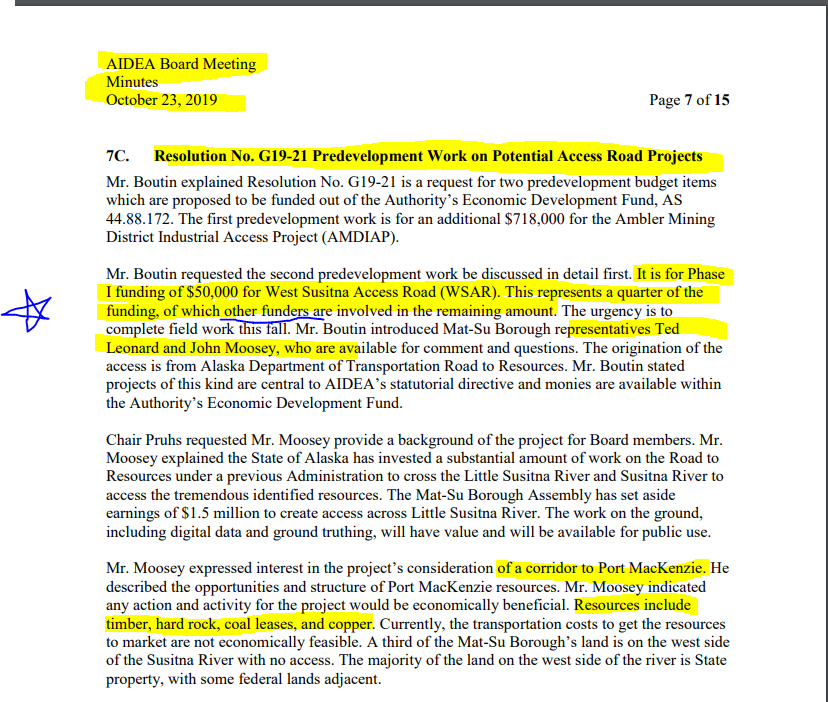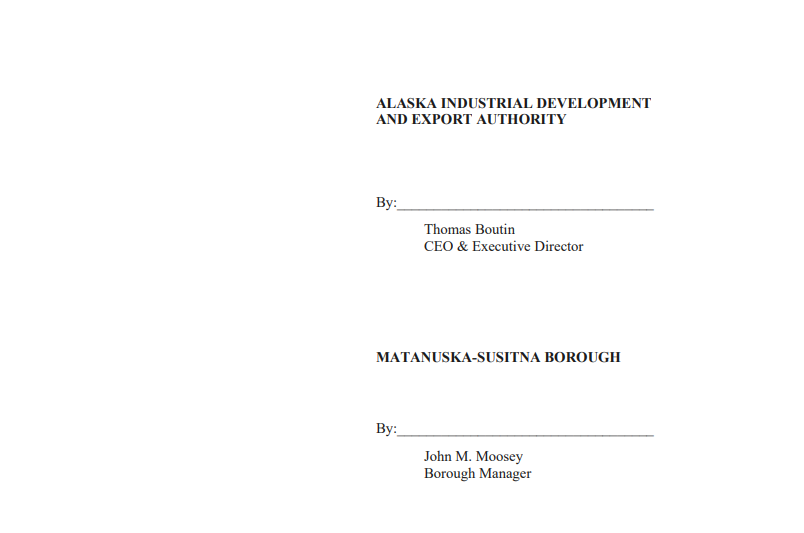Summary: The Fish Creek Access Project is all about resource development. It is connected to the MSB’s ongoing but failed efforts to monetize the Port and Rail Spur and the State’s Road to Resources plans. The Fish Creek project is not really about “public access” to the northern one third of the Mat-Su Borough. The MSB and AIDEA are negotiating behind closed doors to assist undisclosed private companies to get access to (and make money from) our natural resources. Will this benefit the people of the Mat-Su? Why is the MSB always conducting economic development behind closed doors?
The Mat-Su Borough has agreed to pay $50,000 towards the pre-development costs. AIDEA is also kicking in $50,000. And some mysterious “private funders” may kick in another $100,000.
HDR was chosen as the pre-development contractor. There doesn’t seem to have been any RFP.
I found these documents on AIDEA’s website. They are nowhere to be found on the MSB’s website. Note: If the MSB manager gave these AIDEA docs to the Assembly, then they should also have been posted on the MSB website per the open meetings act. Better yet, the MSB-AIDEA partnership should have been brought forward at an Assembly meeting and discussed and voted on.
The MSB needs to reveal who it is dealing with behind closed doors regarding capital projects. The public has a right know because this type of “economic development” involves public money, public land and natural resources. Also, it doesn’t seem fair to negotiate with “favored” companies and set things up for them behind the scenes. The potential “private” funders are likely the coal company and the private railway because those folks are part of the Fish Creek/W Susista Road “working group” email list. Any meetings of this “working group” should be noticed, open public meetings.
MSB Manager John Moosey and Assembly member Ted Leonard attended an AIDEA Board meeting on Oct 23, 2019 and a resolution was passed re: this project.
IMPORTANT NOTE: Ted Leonard served as the Executive Director of AIDEA from 2008 until 2015.


Here are more documents from AIDEA including the Memorandum of Understanding between AIDEA and the MSB:










LINK to the State of Alaska DOT’s comprehensive “West Susitna Access Reconnaissance Study” from 2014: http://dot.alaska.gov/roadstoresources/westsusitna/index.shtml
MORE ON THE MSB HIDING THE BALL:
The AIDEA meeting came just 8 days after the Mat-Su Borough Assembly’s Oct 15, 2019 meeting when the Assembly passed the “fishy” Fish Creek Access ordinance. OR 19-101. This ordinance was originally heard on Sept 3, 2019. It was an ordinance that strangely combined the Willow Library $ and the Fish Creek Access $. Luckily, Assembly member George McKee moved to bifurcate the two items..so the Fish Creek item was delayed until the Oct 15th meeting.
Anyhow, I went back and listened to the Oct 15th Assembly meeting discussion about the Fish Creek project because I had a recollection that the MSB sold this fishy ordinance as – we are looking for GRANTS to fund the road project and it will open up all sorts of opportunities such as timber, fishing, hunting, and other recreational opportunities etc. Gov’t grants are very different from Private investors. Also, timber, fishing, hunting, and recreating is a lot different than COAL MINING.
The fish creek ordinance discussion starts at hour 2 minute 39.
Just as I remembered, the discussion centered around setting aside the MSB’s 1.5 million in order to have a pool of money ready to go if the MSB could find matching grant money to fund the entire $6 million project.
Assembly Member Dan Mayfield used the word grants repeatedly and said if we get matching grant money, we will be able to go ahead with this project to open up commercial opportunities such as “forest, timber, oil, and fish” and “recreational opportunities.”
Jim Sykes called the ordinance fairly vague and asked more questions about it.
Eric Phillips, the MSB land mgmt director, took to the microphone and explained that the project would fund two bridges – one over the Little Su river and one over a smaller unnamed stream – and a roadway for access to the Fish Creek area. He mentioned that the federal grants the MSB was interested in were – “Pittman-Robertson” and EDA. The Pittman-Robertson grant program is federal money to preserve wildlife and hunting. EDA are Economic Development grants.
Mr. Phillips also stated that the MSB had recently met with AIDEA reps as well as Gov Dunleavy and his staff and “they are very interested.”
Now – why weren’t all of these details put in the Informational Memo attached to the Ordinance?
Also, why didn’t the MSB mention anything about the upcoming AIDEA meeting and the MOU (which was probably almost completely drafted at that point), the $50K the MSB pledged to invest, HDR’s involvement, and the potential private investors – who seem to have ties to COAL mining?
MSB Assembly member Ted Leonard had the last word. He seemed a bit annoyed that anyone was even questioning this ordinance or the project. “This is what we are here for! To invest in infrastructure and our resources. This money is a reserve for saying – we want to work with private entities and gov’t entities to invest in our resources.”
However, by this point in time, Leonard, the former director of AIDEA, was clearly already involved in the behind the scenes planning with AIDEA execs, MSB manager Moosey, and Gov Dunleavy’s staff…and probably also the potential “private investors”…but he didn’t reveal ANY OF THIS during the Assembly meeting.
It is not really fair to the citizens of the Mat-Su Valley for the Mat-Su Borough staff and Assembly members to not explain everything that is going on UP FRONT.
The MSB-AIDEA MOU and the $50,000 investment should have been brought to light at an Assembly meeting and VOTED on.
Maybe the public does want a road built through the northern part of the Mat-Su Valley…but perhaps we want to use it primarily for tourism and recreational opportunities – not resource development or coal mining. These important discussions should take place at open meetings – not behind closed doors.







[…] As longtime MatsuMuckraker readers know, the MSB has been meeting with AIDEA for many months and the MSB has already pledged 50K and signed an MOU with AIDEA re: the West Susitna Access project. https://matsumuckraker.com/2020/02/19/more-info-on-the-fish-creek-access-project-aideas-involvement-… […]